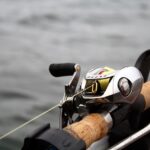The Essential Equipment for Freshwater Fishing: Rods, Reels, and More
Freshwater fishing is a popular outdoor activity enjoyed by millions of people around the world. Whether you are a seasoned angler or a beginner, having the right equipment is essential to a successful fishing trip. In this article, we will discuss the essential equipment for freshwater fishing, including rods, reels, and more.
Rods
The fishing rod is perhaps the most important piece of equipment for any angler. The rod is what you use to cast your line and reel in your catch. There are many different types of fishing rods available, each designed for specific types of fishing and fish species.
Spinning Rods
Spinning rods are the most common type of fishing rod used by freshwater anglers. They are versatile and can be used for a wide range of fish species and fishing techniques. Spinning rods are designed to work with spinning reels and are available in a range of lengths and powers. Shorter spinning rods are ideal for fishing in smaller bodies of water or where space is limited, while longer spinning rods are better for larger bodies of water and longer casts.
Casting Rods
Casting rods are designed for more specialized fishing techniques, such as baitcasting or trolling. They are often more powerful and have a shorter length than spinning rods, making them ideal for targeting larger fish species like bass or pike. Casting rods are designed to work with baitcasting reels and require a bit more skill to use effectively.
Fly Rods
Fly fishing is a specialized form of fishing that uses a different type of rod than spinning or casting rods. Fly rods are designed to work with a fly reel and are used to cast a lightweight fly or lure rather than a heavier bait. Fly fishing requires a lot of skill and patience, but it can be a very rewarding way to catch fish.
Reels
The fishing reel is the mechanism that holds and retrieves your fishing line. Like fishing rods, there are many different types of fishing reels available, each designed for specific types of fishing and fish species.
Spinning Reels
Spinning reels are the most popular type of fishing reel used by freshwater anglers. They are easy to use, versatile, and can be used for a wide range of fish species and fishing techniques. Spinning reels are designed to work with spinning rods and are available in a range of sizes and gear ratios. Smaller spinning reels are ideal for fishing in smaller bodies of water, while larger spinning reels are better for targeting larger fish species like bass or pike.
Baitcasting Reels
Baitcasting reels are designed for more specialized fishing techniques like trolling or casting heavier lures. They are often more powerful than spinning reels and require more skill to use effectively. Baitcasting reels are designed to work with casting rods and are available in a range of sizes and gear ratios. They are often used to target larger fish species like bass or pike.
Fly Reels
Fly reels are designed to work with fly rods and are used to hold and retrieve the fly line. They are available in a range of sizes and are often lightweight and durable. Fly reels are designed to be used with a drag system, which helps to control the fish during the fight.
Fishing Line
Fishing line is what connects your rod and reel to your bait or lure. There are many different types of fishing line available, each designed for specific types of fishing and fish species.
Monofilament Line
Monofilament line is the most common type of fishing line used by freshwater anglers. It is affordable, easy to use, and can be used for a wide range of fish species and fishing techniques. Monofilament line is available in a range of strengths and can be used in both spinning and baitcasting reels.
Braided Line
Braided line is a type of fishing line that is made up of multiple strands of synthetic fibers woven together. It is stronger and more sensitive than monofilament line, making it a popular choice for anglers targeting larger fish species or using more specialized fishing techniques. Braided line is often used in spinning reels and requires a bit of skill to tie knots effectively.
Fluorocarbon Line
Fluorocarbon line is a type of fishing line that is virtually invisible underwater. It is often used in clear or shallow water, where fish may be spooked by the sight of the line. Fluorocarbon line is more expensive than monofilament line but offers superior sensitivity and abrasion resistance.
Leaders
Leaders are short lengths of fishing line that are attached to the end of your main fishing line. They are designed to provide additional strength, abrasion resistance, or invisibility to your fishing setup. Leaders are often used when fishing for larger or more finicky fish species.
Hooks
Fishing hooks are the pointy metal objects that are attached to your fishing line and used to catch fish. There are many different types of fishing hooks available, each designed for specific types of fishing and fish species.
Jig Hooks
Jig hooks are a type of fishing hook that is used in combination with a jig or lure. They are designed to mimic the movement of a baitfish or other prey and are often used to target larger fish species like bass or walleye.
Treble Hooks
Treble hooks are a type of fishing hook that has three points instead of one. They are often used in combination with crankbaits or other lures and are designed to increase your chances of hooking a fish.
Circle Hooks
Circle hooks are a type of fishing hook that is designed to be more humane and reduce the likelihood of gut-hooking a fish. They are often used in combination with live bait and are designed to set themselves in the fish’s mouth when the fish takes the bait.
Sinkers
Fishing sinkers are small weights that are attached to your fishing line to help it sink to the bottom of the water column. They are often used when fishing in deeper water or when targeting bottom-dwelling fish species like catfish or carp.
Bobbers
Fishing bobbers, also known as floats, are small buoyant objects that are attached to your fishing line to indicate when a fish takes the bait. They are often used when fishing with live bait and are designed to keep the bait at a specific depth in the water column.
Lures
Fishing lures are artificial baits that are used to attract fish. They come in many different shapes, sizes, and colors and are designed to mimic the movement and appearance of real baitfish or other prey.
Crankbaits
Crankbaits are a type of fishing lure that is designed to mimic the movement of a baitfish or other prey. They are often used to target larger fish species like bass or walleye and come in a range of sizes and colors.
Spinnerbaits
Spinnerbaits are a type of fishing lure that has a rotating blade attached to a jig or hook. They are designed to create vibration and flash in the water, which can attract fish from a distance.
Soft Plastic Baits
Soft plastic baits are a type of fishing lure that is made from a soft, flexible material like rubber or silicone. They are often used in combination with a jig or hook and come in a range of shapes and colors.
In conclusion, having the right equipment is essential to a successful freshwater fishing trip. Fishing rods, reels, fishing line, leaders, hooks, sinkers, bobbers, and lures are all important components of a well-rounded fishing setup. By choosing the right equipment for your specific fishing needs, you can increase your chances of catching more fish and having a more enjoyable time on the water.
When selecting your equipment, it’s important to consider the fish species you’ll be targeting and the type of water you’ll be fishing in. For example, if you’ll be targeting bass in a lake, a medium-heavy spinning rod with a fast action may be a good choice. On the other hand, if you’ll be targeting trout in a small stream, a light spinning rod with a slow or medium action may be more appropriate.
When it comes to selecting fishing line, it’s important to choose a line that is appropriate for your fishing technique and the fish species you’ll be targeting. Monofilament line is a good all-around choice for most freshwater fishing situations, but braided line and fluorocarbon line may be more appropriate for specific techniques or fish species.
When selecting fishing hooks, it’s important to choose a hook size and style that is appropriate for the bait you’ll be using and the fish species you’ll be targeting. For example, if you’ll be using live worms as bait, a small size 6 or 8 hook may be appropriate. If you’ll be using larger lures or baits, a larger size 2 or 4 hook may be more appropriate.
Fishing sinkers and bobbers are important components of a fishing setup, particularly when targeting bottom-dwelling fish species or fishing with live bait. When selecting sinkers, it’s important to choose a weight that is appropriate for the depth of water you’ll be fishing in and the current conditions. Bobbers come in a range of sizes and styles and should be selected based on the size of the bait you’ll be using and the depth you’ll be fishing at.
Fishing lures come in a wide range of styles and colors, each designed to mimic the movement and appearance of real baitfish or other prey. When selecting lures, it’s important to consider the fish species you’ll be targeting and the water conditions you’ll be fishing in. Crankbaits and spinnerbaits are popular choices for targeting larger fish species like bass and walleye, while soft plastic baits are a good choice for finesse fishing or targeting finicky fish species like trout.
In addition to the basic fishing equipment listed above, there are a few other items that can make your freshwater fishing trip more enjoyable and successful. These include:
Fishing Pliers
Fishing pliers are a handy tool for removing hooks from fish, cutting fishing line, and making quick repairs to your fishing setup. Look for pliers with a corrosion-resistant coating and a comfortable grip.
Fishing Nets
A fishing net can be a useful tool for landing fish, particularly if you’ll be targeting larger species like bass or pike. Look for a net with a rubberized mesh to minimize damage to the fish’s scales and slime coating.
Fishing Rod Holders
Fishing rod holders can be useful when fishing from a boat or shore, allowing you to keep your hands free and monitor multiple rods at once. Look for rod holders that are adjustable and can accommodate different sizes and styles of fishing rods.
Sun Protection
Sun protection is essential when spending time on the water. Be sure to bring a hat, sunglasses, and sunscreen with a high SPF rating to protect your skin from the harmful effects of the sun.
In conclusion, having the right equipment is essential to a successful and enjoyable freshwater fishing trip. By selecting fishing rods, reels, fishing line, leaders, hooks, sinkers, bobbers, lures, and other accessories that are appropriate for your specific fishing needs, you can increase your chances of catching more fish and having a great time on the water. So next time you plan a fishing trip, be sure to check your gear and make sure you have everything you need for a successful day of fishing.
Additionally, it’s important to take care of your fishing equipment to ensure it lasts for many fishing trips to come. After each trip, rinse your rods, reels, and other equipment with fresh water to remove any salt or debris that may have accumulated. Store your equipment in a dry and cool place to prevent rust and other damage.
When selecting fishing equipment, it can be overwhelming to navigate through the numerous options available on the market. However, doing your research and seeking advice from experienced anglers or fishing retailers can help you make informed decisions and select the right equipment for your needs.
It’s also worth noting that fishing regulations vary by location, so be sure to check with your local fishing authorities to ensure you’re using equipment and techniques that are legal and sustainable.
In summary, having the right fishing equipment is crucial to a successful and enjoyable freshwater fishing trip. By selecting high-quality rods, reels, fishing line, leaders, hooks, sinkers, bobbers, lures, and other accessories that are appropriate for your specific fishing needs, you can increase your chances of catching more fish and having a great time on the water. Don’t forget to take care of your equipment and follow local fishing regulations to ensure a sustainable fishing experience for generations to come.






